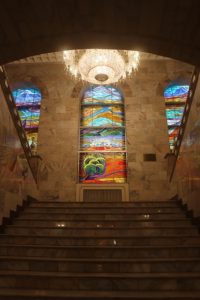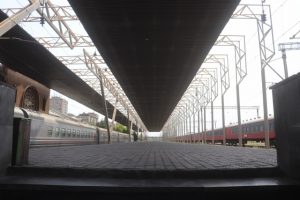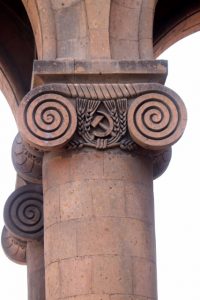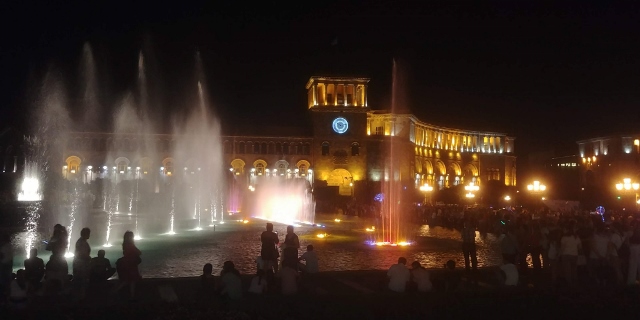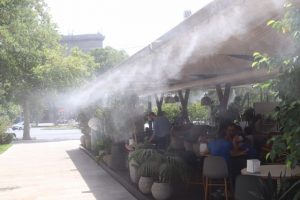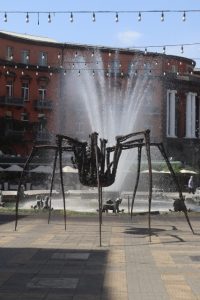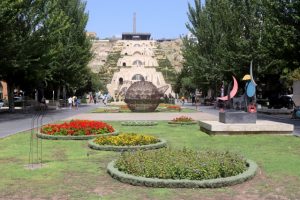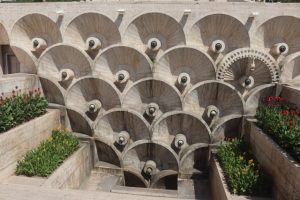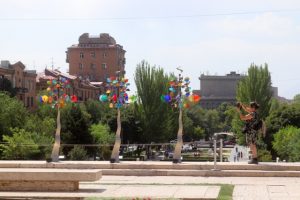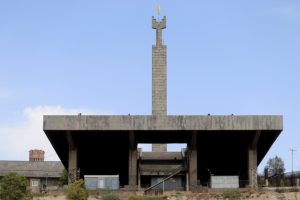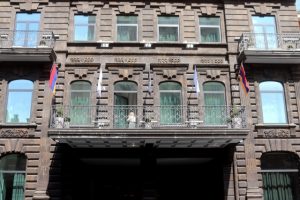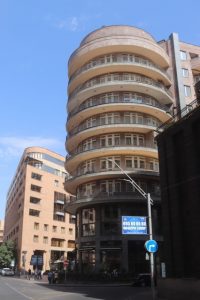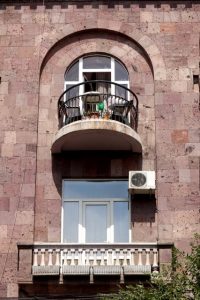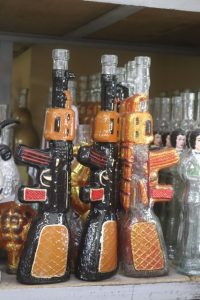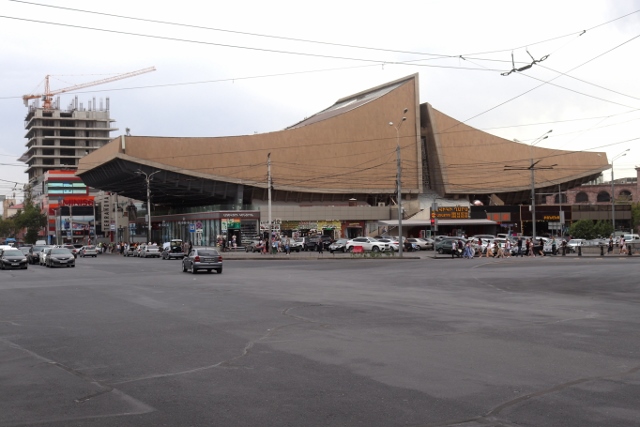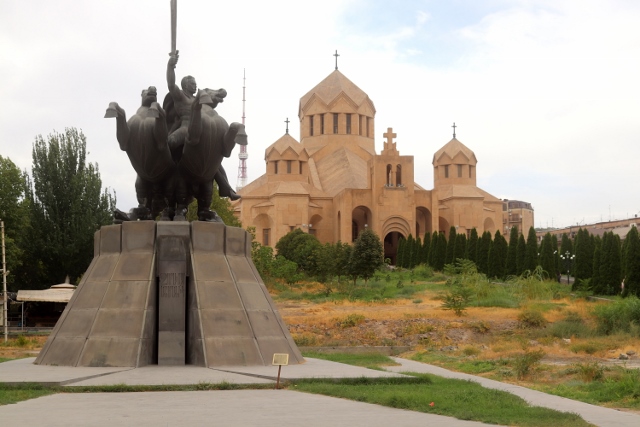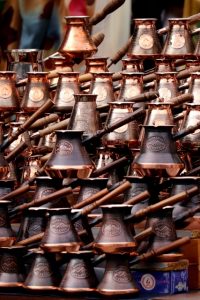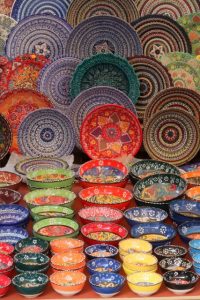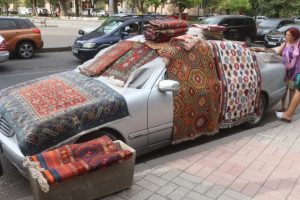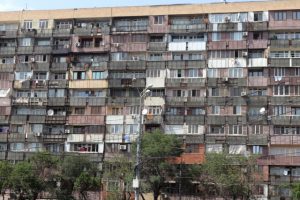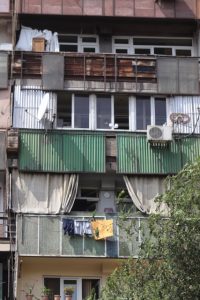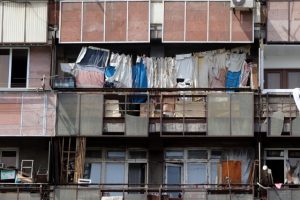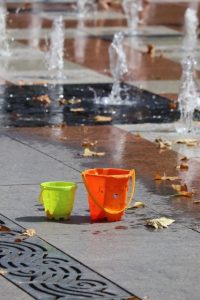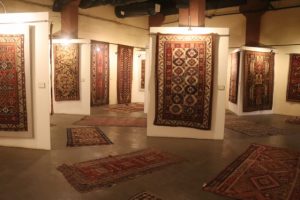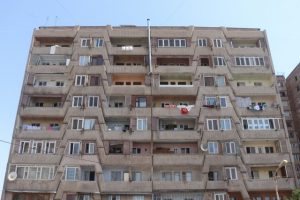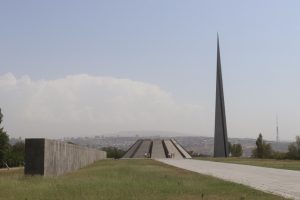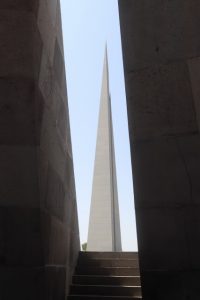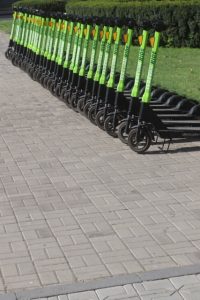The Armenian capital is a modern city, with lots of art and architecture to admire. Yet, traces of its Soviet-dominated past are never far away.
Yerevan is not a particularly pretty city. Wide avenues, large, solemn buildings in grey, beige and brown colours. Most of the present-day layout was designed in the 1920s by Russian-Armenian architect Alexander Tamanyan, after the Russians had incorporated Armenia once again in their empire. Quite a bit of the earlier town had to be demolished, so there are very few real old buildings left. And in fact, much of the subsequent construction now dominating the city is from the 1950-60s, with a distinct Soviet character.
Which already starts at arrival, by train from Tbilisi. The railway station is a huge, Soviet-era structure, with the red star still in place at the top – and hammer and sickle symbols happily used in decorating some of the pillars. The sad part about the station is, of course, that it only supports the arrival and departure of one train a day, the one we came with.
Further Soviet-era buildings surround the heart of Yerevan, Republic Square, a huge circular open space part traffic chaos, part pedestrian area. There is a hotel, museums and government offices, all massive, built from huge Lego-blocks, is seems. The pedestrian area comes to live in the evening, as the fountain, changing colours, dances to the tunes of various popular melodies.
Yet, as a contrast to the large impersonal buildings, there are the sidewalk cafes. I don’t know any other city where there are so many cafes, mostly upmarket, comfortable affairs serving a variety of coffees and cakes. It is hot, in summer, but the solution adopted by most is either a fan spraying fine drops of water, or an intricate distribution system spraying along the terrace edges. Which makes sitting on the terraces quite bearable, actually. Enter good coffee – ice coffee – and delicious cakes…..
In between those coffees and cakes, we take a walk through Yerevan. The first thing that becomes obvious, is that we are not the only ones. Streets are generally full of people, and certainly those in the centre of town are smartly dressed, fast moving, the type you find in any major modern city. And like any such city, Yerevan, too, has the boutiques and fancy shops to match its clientele. The second observation is, that these people are obsessed with sculptures. Everywhere in town are huge sculptures of local heroes, for most of us obscure figures we have never heard of – although Alexander Tamanyan, mentioned above, is also represented. But next to these, there are also lots of jolly sculptures, modern art, or other expressions of creativity – small, almost hidden objects, or clear statements, occupying part of the pavement. Some of those are actually part of the collection of the Yerevan Modern Art Museum – good for us, as the museum’s indoor collection had been stored in favour of a temporary, not-so-interesting exhibition.
All of this culminates in Tamanyan sculpture park, a green patch with an array of sculptures, including several from Fernando Botero. The park merges into the Cascade, another grandiose design which envisaged a water fall coming down from the monument celebrating 50 years of Soviet rule – which was never completed because of the demise of the Soviet Union. Luckily, the complex, including the massive limestone stairs, was privatised, and one of Armenian’s rich families invested in what is now the Cafesijan Centre of the Arts, an interesting collection of mainly sculptures – again! – outside, aligning the stairs, and inside, along the escalator that, thankfully, also leads to the top level. Looking south from here we see, vaguely in the distance, Mount Ararat, the for Armenians holy mountain that for centuries was part of their country, but is now in Turkey.
To be fair, Yerevan has more to offer architecturally, along its often pleasantly tree-lined streets. Some of the buildings are distinctly 1920s, others – like the Moskva cinema, and the fabulous wing-like former Rossiya cinema – are Soviet era additions. One of the newest buildings is the Saint Gregory the Illuminator cathedral, a not unsuccessful attempt to create a modern-look alternative to the typical Armenian church design. A rather disappointing ‘must-see’ – according to the guide books – is The Vernissage, a market with local art and souvenirs, which is mostly mass-produced rubbish. Colourful, though.
An excursion outside the centre is to the carpet factory and museum of Megerian, an Armenia diaspora family who fled the genocide and established themselves in New York in 1917. They set up carpet factories all over the world, and only in 2014 returned to Armenia. We are mostly interested in the museum, which indeed has a selection of fabulous kilims – what Armenians call carpets – and carpets – which Armenians call rugs. Many of the kilims have the production date woven into them, many are well over 100 years old.
What the excursion also shows, is Yerevan beyond the flashy centre, with its run down neighbourhoods and apartment buildings. With people a lot humbler dressed, and with street cafes serving delicious shoarma wraps. And the workings of the Yerevan metro, one line only, but very fast and efficient. Officially, we are not allowed to take pictures inside the metro, and indeed, here crops up the old mentality of the man in a uniform again.
The one thing left to do is to visit the Armenian Genocide Memorial, also outside the centre, on a hill. We take a bus, and walk the last bit up, into the park. Which is, incredibly, rather neglected; you would expect that such a location would receive all the necessary attention, but paths are half broken up, plant sections overgrown. Only nearer the monument, and the associated museum, does it get better, with well-kept trees that, according to the name plates next to them, have been planted by people important enough to warrant a name plate, including many foreigners. The monument itself, erected in 1967, is an impressive pinnacle into the air next to a circle with 12 basalt slabs, surrounding an eternal flame. The museum is equally impressive, or should I say depressive. I thought I knew about the Genocide, but I didn’t even know half of it. There was a lot of foreign outrage, at the time – but little action, let alone intervention. There are lots of the pictures, very confronting. And there is a systematic time line illustrating how this genocide has been carefully planned. Of course, this is only the Armenian version, the persistent Turkish denial is absent here. But the Armenians were the ones who suffered, they were the once who died.
Next: archaeological site Erebuni.
